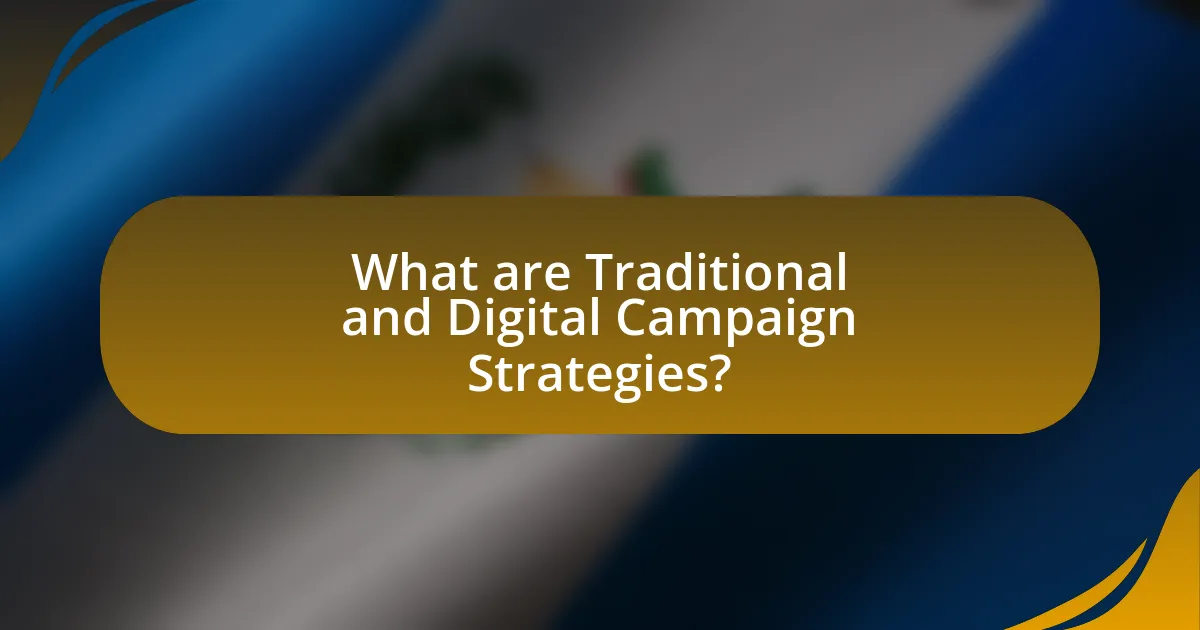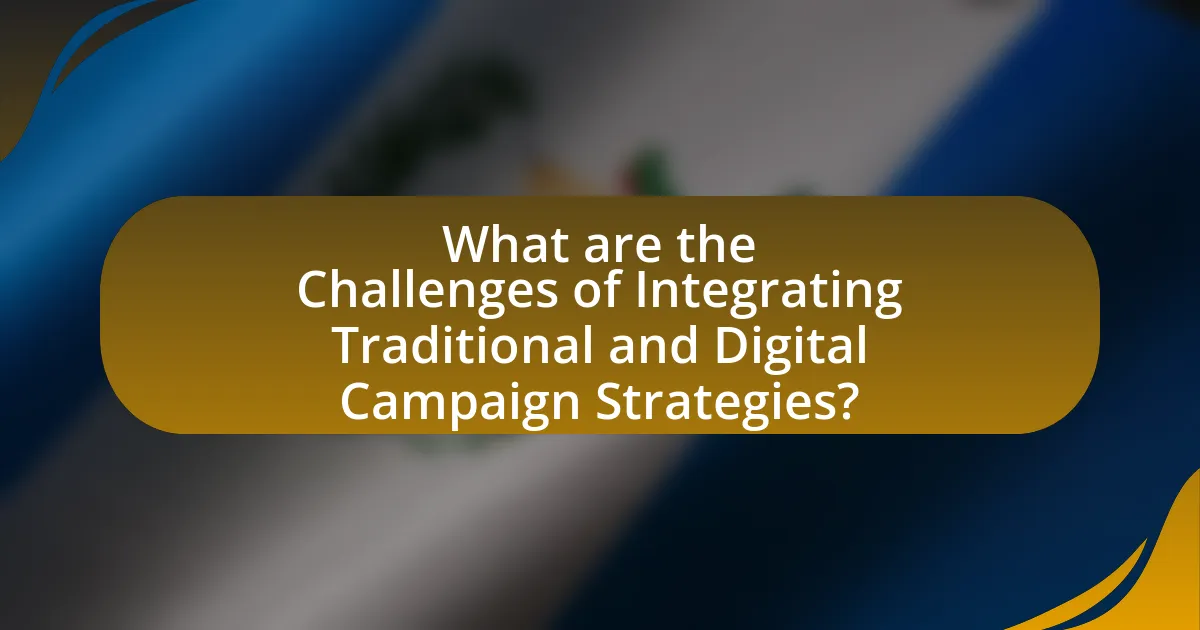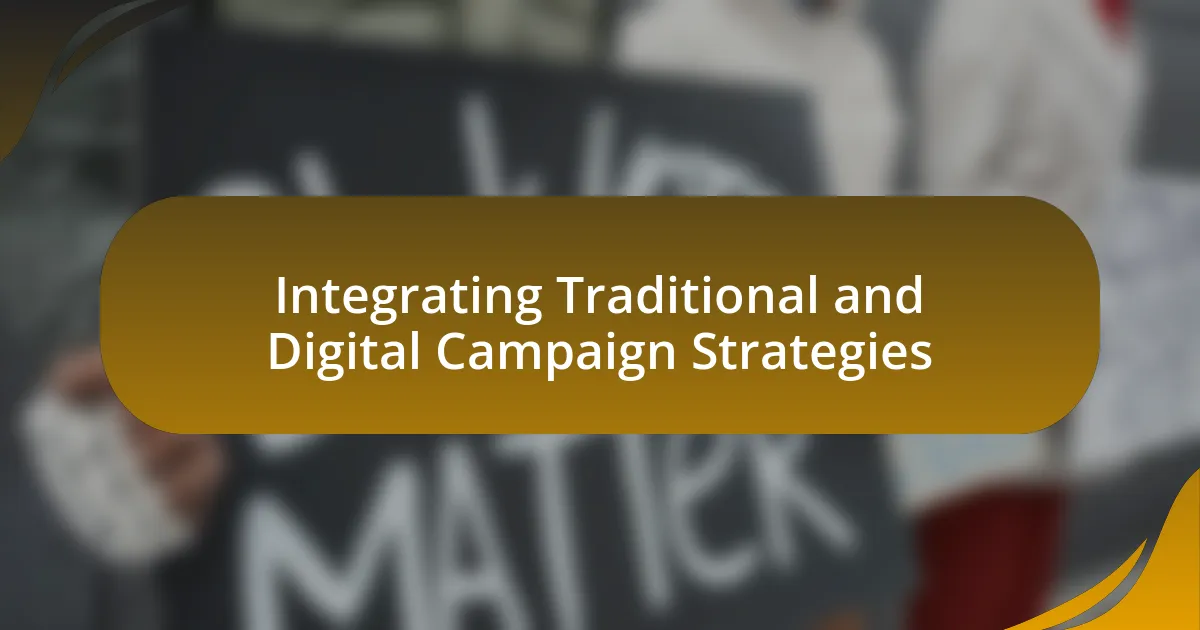The article focuses on the integration of Traditional and Digital Campaign Strategies, highlighting the distinct characteristics and components of each approach. Traditional strategies utilize offline channels such as print and television, while digital strategies leverage online platforms like social media and email marketing. The article emphasizes the importance of combining both strategies to maximize reach and engagement, detailing the advantages of integration, such as improved brand recognition and customer retention. Additionally, it addresses the challenges marketers face during integration, including aligning messaging and measuring effectiveness, and provides best practices for successful implementation.

What are Traditional and Digital Campaign Strategies?
Traditional campaign strategies involve conventional marketing methods such as print advertising, television commercials, radio spots, and direct mail, which have been used for decades to reach broad audiences. These strategies rely on established media channels and often focus on brand awareness and customer engagement through tangible materials.
Digital campaign strategies, on the other hand, utilize online platforms and technologies, including social media, email marketing, search engine optimization (SEO), and pay-per-click (PPC) advertising, to engage with target audiences in real-time. Digital strategies allow for precise targeting, data analytics, and immediate feedback, making them adaptable and measurable.
The effectiveness of these strategies can be seen in their respective reach and engagement metrics; for instance, a 2021 report by Statista indicated that digital advertising spending in the U.S. surpassed $200 billion, reflecting a significant shift towards digital platforms. This data underscores the growing importance of integrating both traditional and digital approaches to maximize campaign effectiveness and reach diverse consumer segments.
How do Traditional Campaign Strategies differ from Digital Campaign Strategies?
Traditional campaign strategies primarily rely on offline channels such as print media, television, and radio, while digital campaign strategies utilize online platforms like social media, email, and websites. Traditional strategies often focus on broad audience reach and brand awareness through mass media, whereas digital strategies emphasize targeted engagement, data analytics, and real-time feedback. For instance, a study by the Interactive Advertising Bureau found that digital advertising allows for precise targeting, with 66% of marketers reporting improved ROI through digital channels compared to traditional methods. This distinction highlights the shift towards data-driven decision-making in marketing, making digital strategies more adaptable and measurable.
What are the key components of Traditional Campaign Strategies?
The key components of Traditional Campaign Strategies include target audience identification, message development, media selection, budget allocation, and performance measurement. Target audience identification involves defining the demographic and psychographic characteristics of the intended audience to tailor the campaign effectively. Message development focuses on creating a compelling narrative that resonates with the audience, ensuring clarity and relevance. Media selection entails choosing appropriate channels such as television, radio, print, and outdoor advertising to reach the audience effectively. Budget allocation is crucial for determining how resources will be distributed across various media and activities to maximize impact. Finally, performance measurement assesses the effectiveness of the campaign through metrics such as reach, engagement, and conversion rates, allowing for adjustments in future strategies. These components are foundational in ensuring that traditional campaigns achieve their intended objectives.
What are the key components of Digital Campaign Strategies?
The key components of Digital Campaign Strategies include target audience identification, content creation, channel selection, performance measurement, and optimization. Target audience identification involves defining the demographics and behaviors of potential customers to tailor messages effectively. Content creation focuses on developing engaging and relevant material that resonates with the audience, utilizing formats such as videos, blogs, and social media posts. Channel selection refers to choosing the appropriate platforms, such as social media, email, or search engines, to reach the target audience effectively. Performance measurement involves analyzing metrics like click-through rates, conversion rates, and engagement levels to assess the campaign’s success. Finally, optimization is the process of refining strategies based on performance data to improve future campaigns. These components are essential for creating effective digital marketing initiatives that drive engagement and conversions.
Why is it important to integrate Traditional and Digital Campaign Strategies?
Integrating Traditional and Digital Campaign Strategies is important because it maximizes reach and engagement across diverse audience segments. By combining the broad visibility of traditional media, such as television and print, with the targeted precision of digital platforms, marketers can create a cohesive message that resonates with both demographics and psychographics. Research indicates that campaigns utilizing both strategies can achieve up to 30% higher engagement rates compared to those relying solely on one approach, demonstrating the effectiveness of a multi-channel strategy in capturing consumer attention and driving conversions.
What advantages does integration provide for marketing effectiveness?
Integration enhances marketing effectiveness by creating a cohesive brand message across multiple channels. This consistency improves brand recognition and trust, leading to higher customer engagement. According to a study by the Aberdeen Group, companies with integrated marketing strategies experience a 20% increase in customer retention rates compared to those without integration. Furthermore, integrated campaigns allow for better data sharing and analysis, enabling marketers to optimize their strategies based on comprehensive insights. This holistic approach not only maximizes reach but also improves return on investment, as evidenced by a report from HubSpot indicating that integrated campaigns can yield up to 30% higher conversion rates.
How does integration enhance audience reach and engagement?
Integration enhances audience reach and engagement by combining traditional and digital marketing strategies to create a cohesive message across multiple platforms. This approach allows brands to tap into diverse audience segments, as traditional media can reach demographics that may not be active online, while digital channels can engage users with interactive content. For instance, a study by Nielsen found that integrated campaigns can increase brand recall by up to 68%, demonstrating that a unified strategy effectively captures attention and fosters deeper connections with consumers.

What are the Challenges of Integrating Traditional and Digital Campaign Strategies?
The challenges of integrating traditional and digital campaign strategies include aligning messaging across platforms, measuring effectiveness, and managing resource allocation. Aligning messaging is crucial because inconsistent communication can confuse audiences; for instance, a study by the American Marketing Association found that 70% of consumers prefer a unified brand message. Measuring effectiveness poses difficulties due to differing metrics and analytics tools used in traditional versus digital media, complicating the assessment of overall campaign performance. Additionally, managing resource allocation is challenging as businesses must balance budgets and personnel between traditional and digital channels, which can lead to inefficiencies if not strategically planned.
What common obstacles do marketers face during integration?
Marketers commonly face challenges such as data silos, inconsistent messaging, and technology integration during the integration of traditional and digital campaign strategies. Data silos occur when information is isolated within different departments, hindering a unified approach. Inconsistent messaging arises when brands fail to maintain a cohesive voice across various platforms, leading to confusion among consumers. Additionally, technology integration issues can stem from using disparate systems that do not communicate effectively, complicating the execution of integrated campaigns. These obstacles can significantly impact the overall effectiveness of marketing efforts, as evidenced by a study from the Harvard Business Review, which found that companies with aligned marketing strategies see a 20% increase in customer engagement.
How can differing metrics between traditional and digital campaigns complicate integration?
Differing metrics between traditional and digital campaigns complicate integration by creating challenges in measuring overall campaign effectiveness and aligning strategies. Traditional campaigns often rely on metrics such as reach and impressions, while digital campaigns focus on engagement, conversion rates, and real-time analytics. This disparity can lead to misinterpretations of performance, as traditional metrics may not accurately reflect the immediate impact of digital efforts. For instance, a study by the Interactive Advertising Bureau found that 70% of marketers struggle to integrate data from both channels due to these differing measurement standards, resulting in inefficient resource allocation and strategic misalignment.
What role does budget allocation play in the integration process?
Budget allocation is crucial in the integration process as it determines the resources available for both traditional and digital campaign strategies. Effective budget allocation ensures that each channel receives adequate funding to optimize performance and achieve marketing objectives. For instance, a study by the American Marketing Association found that companies that strategically allocate budgets between digital and traditional media see a 20% increase in overall campaign effectiveness. This demonstrates that thoughtful budget distribution directly impacts the success of integrated marketing efforts.
How can organizations overcome these challenges?
Organizations can overcome challenges in integrating traditional and digital campaign strategies by adopting a unified marketing approach that leverages data analytics and cross-channel collaboration. This approach enables organizations to create cohesive messaging and optimize resource allocation across platforms. For instance, a study by the Harvard Business Review found that companies using integrated marketing strategies experienced a 20% increase in customer engagement compared to those using siloed approaches. By utilizing customer data to inform both traditional and digital efforts, organizations can enhance targeting and improve overall campaign effectiveness.
What strategies can be employed to align teams and resources?
To align teams and resources effectively, organizations can implement clear communication protocols, establish shared goals, and utilize collaborative tools. Clear communication ensures that all team members understand their roles and responsibilities, which fosters accountability and reduces misunderstandings. Establishing shared goals aligns individual efforts with the organization’s objectives, promoting a unified direction. Utilizing collaborative tools, such as project management software, enhances coordination and resource allocation, allowing teams to work together efficiently. Research indicates that organizations with aligned teams and resources experience a 20% increase in productivity, demonstrating the effectiveness of these strategies.
How can technology facilitate the integration of campaign strategies?
Technology facilitates the integration of campaign strategies by enabling seamless communication and data sharing across various platforms. For instance, marketing automation tools allow businesses to synchronize their traditional and digital marketing efforts, ensuring consistent messaging and targeting. According to a report by HubSpot, companies that use integrated marketing strategies experience a 20% increase in sales opportunities. Furthermore, analytics tools provide real-time insights into campaign performance, allowing marketers to adjust strategies dynamically based on data-driven decisions. This integration enhances overall campaign effectiveness and improves return on investment.

What Best Practices Should be Followed for Successful Integration?
Successful integration of traditional and digital campaign strategies requires a cohesive approach that aligns messaging across all platforms. This involves ensuring consistent branding, utilizing data analytics to inform decisions, and fostering collaboration between teams managing different channels. Research indicates that brands that maintain a unified message across traditional and digital platforms see a 23% increase in customer engagement, highlighting the importance of consistency. Additionally, leveraging customer insights from digital campaigns can enhance the effectiveness of traditional marketing efforts, creating a synergistic effect that maximizes reach and impact.
How can marketers effectively plan for integration?
Marketers can effectively plan for integration by establishing a unified strategy that aligns traditional and digital campaign efforts. This involves conducting a thorough analysis of target audiences across both channels to ensure messaging consistency and relevance. For instance, a study by the Content Marketing Institute found that 70% of marketers who integrate their campaigns report improved customer engagement. Additionally, utilizing data analytics tools allows marketers to track performance metrics across platforms, enabling real-time adjustments and optimization of campaigns. This data-driven approach ensures that both traditional and digital strategies work synergistically, maximizing reach and impact.
What steps should be taken to create a cohesive campaign strategy?
To create a cohesive campaign strategy, organizations should first define clear objectives that align with their overall goals. This involves identifying target audiences and understanding their preferences across both traditional and digital platforms. Next, organizations must develop a unified message that resonates with these audiences, ensuring consistency in tone and branding across all channels.
Following this, a detailed plan should be established, outlining the specific tactics and channels to be used, such as social media, email marketing, print advertising, and events. It is essential to allocate resources effectively, including budget and personnel, to support the execution of the strategy.
Finally, organizations should implement a system for monitoring and evaluating the campaign’s performance, using metrics such as engagement rates, conversion rates, and return on investment to assess effectiveness and make necessary adjustments. This structured approach ensures that all elements of the campaign work together harmoniously, maximizing impact and reach.
How can data analytics be utilized to inform integrated strategies?
Data analytics can be utilized to inform integrated strategies by providing actionable insights that guide decision-making across both traditional and digital marketing channels. By analyzing consumer behavior data, organizations can identify trends, preferences, and engagement patterns that inform the development of cohesive marketing strategies. For instance, a study by McKinsey & Company found that companies using data analytics effectively can increase their marketing ROI by 15-20%. This demonstrates that leveraging data analytics not only enhances targeting and personalization but also optimizes resource allocation across various platforms, ensuring a unified approach to campaign execution.
What are some examples of successful integrated campaigns?
Some examples of successful integrated campaigns include Coca-Cola’s “Share a Coke,” which combined personalized bottles with social media engagement, resulting in a 2% increase in U.S. sales. Another example is Nike’s “Just Do It” campaign, which effectively utilized television, print, and digital platforms to create a cohesive brand message, leading to a significant boost in brand loyalty and sales. Additionally, the ALS Association’s “Ice Bucket Challenge” integrated social media with traditional fundraising efforts, raising over $115 million for ALS research in a short period. These campaigns demonstrate the effectiveness of blending traditional and digital strategies to achieve measurable results.
What lessons can be learned from these successful campaigns?
Successful campaigns demonstrate the importance of a cohesive strategy that effectively integrates traditional and digital marketing methods. These campaigns highlight that understanding the target audience is crucial; for instance, utilizing data analytics from digital platforms can inform traditional media placements, ensuring messages reach the right demographics. Additionally, successful campaigns often leverage storytelling across both mediums, creating a unified brand narrative that resonates with consumers. Evidence from case studies, such as the “Share a Coke” campaign, shows that personalized engagement through digital channels can enhance the impact of traditional advertising, leading to a 7% increase in sales. Thus, the key lessons include the necessity of audience insight, the power of cohesive storytelling, and the effectiveness of personalized engagement.
What practical tips can marketers implement for effective integration?
Marketers can implement several practical tips for effective integration of traditional and digital campaign strategies. First, they should ensure consistent messaging across all platforms, as studies show that cohesive branding can increase customer recognition by up to 80%. Second, utilizing data analytics from digital campaigns can inform traditional marketing efforts, allowing for targeted outreach based on consumer behavior insights. Third, integrating social media with traditional advertising, such as including hashtags in print ads, can drive online engagement and create a unified customer experience. Lastly, conducting regular cross-channel performance reviews helps marketers adjust strategies in real-time, optimizing both traditional and digital efforts for better overall results.
